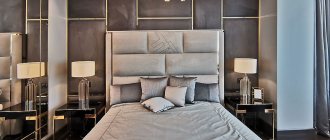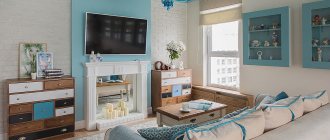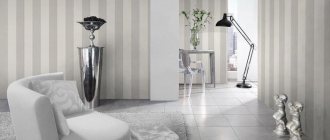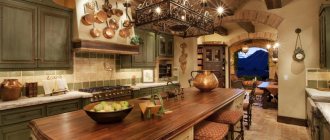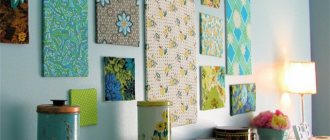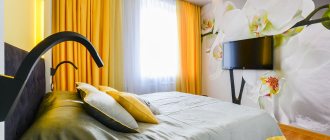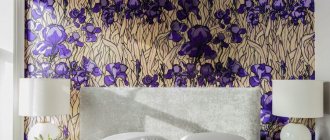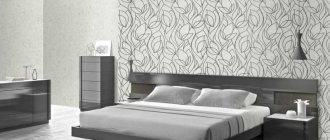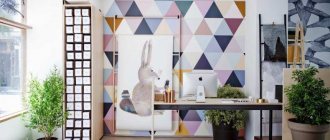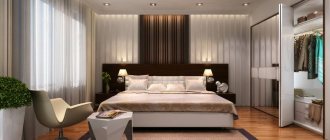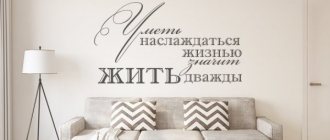Moldings in the interior for separating wallpaper and framing sections of the wall serve as additional decorative elements that give the overall composition the necessary completeness. Thanks to such finishing details, you can not only separate, but also combine different zones into a single interior space.
Moldings in the interior for dividing wallpaper
Moldings act as delimiters of surfaces of different appearance, color and tone, covered with wallpaper or even simply painted. In addition, with such decorative details it is quite possible to visually expand or narrow the space, “raise” or “lower” the ceiling. What moldings are made of and how such decoration is made will be discussed further in this publication.
Benefits of using moldings
Moldings have been used for quite a long time both for external decoration of buildings and indoors. They first came into widespread use back in Khrushchev's times.
Despite the fact that they are rarely used in modern design, since they look most appropriate in ancient styles, moldings have a number of advantages that make them relevant in our time.
The benefits of using planks in the interior and the features of their use are as follows:
- No problems with installation and maintenance. The back side of the parts is flat, which allows it to fit tightly to the surface and hold tightly. Therefore, during installation, an adhesive composition is simply applied to it and the part is pressed tightly against the wall. Maintenance is also quite simple - all surfaces can be simply wiped with a damp cloth if necessary.
- Cheapness. A wide selection of moldings from different materials and configurations allows you to choose a model to suit every taste and budget. Decorative skirting boards made of polyurethane are currently most in demand. This is due to their durability and reasonable price.
- It is possible to paint them in any color. Paint adheres well to moldings made of any materials, with which you can make a smooth transition between contrasting wallpaper.
- Eliminate surface imperfections. Using a decorative plinth, you can smooth out the transition between coatings with different textures and disguise any damage or unevenness on the wall.
- Can be glued to walls, including wallpaper, to the ceiling and to the floor around the perimeter of the room.
Also, an undoubted benefit of using moldings in the interior is the wide variety of models that allow you to select any types of moldings for different types of interior designs.
Moldings in various interior styles
Moldings for finishing certain surfaces of residential premises are used in a wide variety of interior design styles.
Types of molding reliefs that are great for Mediterranean and antique styles.
Most relief strips and shaped decorative elements are suitable for almost all interior styles, but for some of them you have to choose a specific version of volumetric patterns.
"Baroque"
The Baroque style is replete with moldings and decorative details with embossed plant patterns. One could even argue that it is they who create the general mood of such interior design.
The Baroque style is suitable for decorating living rooms, bedrooms, and dining rooms. Often used in private houses built in the same style.
Previously, these stucco elements decorating the ceiling and walls were made from gypsum, and it can safely be called a traditional material for their manufacture. Today, in specialized stores you can choose moldings with various volumetric reliefs made from lighter materials, which are much simpler and more convenient to install. In addition, they can be easily tinted in any color.
In this style, light colors predominate, so the surfaces are decorated with white or gilded “stucco”.
To decorate the ceiling surface, a whole complex of moldings is used, consisting of straight strips and elements with various shapes and relief patterns. In the Baroque style, these details are placed on the ceiling symmetrically relative to the center of the surface, which, in turn, is decorated with a decorative rosette for a chandelier.
In the Baroque style, in addition to linear moldings, a decorative rosette for a chandelier necessarily suggests itself, strictly in the center of the ceiling surface
On the walls, with the help of molding strips, unique panels of different perimeter are formed, which are painted or covered with wallpaper of the same or different color from the main surface, but in good harmony with the overall background. In this case, moldings serve as framing elements that help maintain the interior style. Furniture, flooring, as well as draperies - curtains on windows or niches - should also match the design of the walls.
"Provence"
A popular style for decorating rooms in modern houses and apartments is “Provence”. Inspired by the warm influences of southern France, this style provides a cozy environment conducive to rest and relaxation.
Moldings are not a mandatory element of finishing in the Provence style, however, they are used here too
It is very convenient that this style allows the use of creative improvisation in the design, since it is not particularly limited in the use of certain elements. In the Provence style, simple-shaped moldings with simple geometric reliefs are used, and painted in colors that are in harmony with the basic tones of the room design. In the decoration of this style, framing elements can be fixed at the junctions of the surfaces of walls and floors, as well as walls and ceilings - this is the same case when they are otherwise called floor and ceiling plinths.
To decorate the main area of walls in the Provence style, moldings are used less frequently. However, sometimes simple versions of planks are still used to frame mirrors, window and door openings, as well as to set the height limit of the lower, “panel” part of the walls
Another technique used in this style solution is a combination of moldings that are different in width, shape, and color. A decorative fireplace in the Provence style would also be appropriate, but only one assembled from molding elements with simple relief shapes.
In the Provence style, even on the ceiling rosette for a chandelier, “pretentiousness” is not welcome - everything is much simpler
Ceiling rosettes for a chandelier in the Provence style are distinguished by their simplicity of relief and do not have complex floral or geometric volumetric patterns.
Classic style
Another favorite option for decorating apartments, especially those located in old houses with arched windows and high ceilings, is the classic style. Thanks to the presence of similar architectural forms, this direction suggests itself for decorating such rooms. In some cases, the owners of newly built private houses deliberately choose an architectural project made in this style, and then decorate the interiors accordingly.
Prices for wallpaper for painting
wallpaper for painting
The classic style always involves arched structures, which will require either curly or flexible moldings
Typically, furniture used in classic decoration is made of natural dark or tinted wood and has carved frames of various configurations. Using the same principle, it is advisable to select the reliefs of moldings used for finishing walls, arches of windows and doors.
Scandinavian style
The Scandinavian version of the design of living rooms is also not forgotten in interior design, and it is used in various variations. Basically, this approach uses modern furniture accessories with strict lines and geometric shapes, but they are smoothed out by numerous pillows, soft blankets placed on sofas and small floor carpets with piles of different lengths.
Moldings in the Scandinavian design style emphasize the distinctly neat lines of the interior decoration
Moldings in this style of room decoration are suitable for framing arches, windows, ceilings and floors. Here, such decorative elements are not the main details - they are used as auxiliary ones and emphasizing the evenness of the walls and the neatness of the interior. If the design is done in light colors, then white moldings are matched to it. If other shades are used for painting or gluing surfaces, a light frame can also be chosen, or the moldings can be painted in tones close to the main colors of the overall design of the room.
Mediterranean style
The Mediterranean style of room design assumes the presence of wide doors or large windows, behind which a spatial perspective opens up with the sea water surface. It is clear that not all apartments have windows or balconies overlooking the sea, lake or simply a beautiful corner of exotic nature. Therefore, when recreating this style, they often use appropriate painting on plaster or high-quality photo wallpaper.
Using a Mediterranean style to decorate a room, it is possible to visually lengthen or expand it.
In this interior design style of rooms, moldings are used in all sorts of ways - this is a clear highlighting of the panel part on the walls, framing arches and doorways, the ceiling, as well as the obligatory section of the wall with paintings or photo wallpaper. Molding strips are fixed around the wall images and columns or semi-columns are installed as a continuation of the arcade pattern, simulating an exit to a balcony or street. This design of the room visually expands its space due to the perspective of the image and the installation of external decorative elements next to it.
Using decorative moldings on the walls of a Mediterranean-style room
If the room already has a large window, a completely glass door, or a picturesque image is applied to the wall, but you would like to complement the interior with elements that enhance the direction of the style, you can use appropriate furniture, accessories and finishing materials. For example, narrow small sofas with straight backs are suitable for this style, the role of which can be played by a wall decorated with moldings, near which this seating area is installed. Natural mats are used as carpets, and curtain draperies and furniture covers are made from linen or cotton fabrics.
Mediterranean style involves light or pastel colors, as well as freedom and lightness of space. It would be useful to place a flowerpot with some exotic plant in the room.
Romantic style
The romantic style is great for decorating a bedroom, as it uses pastel, non-aggressive colors that will have a positive effect on a person’s psyche and his mood - pale pink, light green, blue, etc.
Neat white moldings look great on delicate tones of decoration in a romantic style
These shades will go well with the white color of the moldings framing the walls and furniture accessories. In this style, it is acceptable to use molding strips of any shape and width, emphasizing the lines of the interior elements. Other decorative elements are also acceptable, but without much “pretentiousness”. They are mounted on walls, ceilings, built-in cabinets, niches and arches, and in some cases it would be useful to install one or two columns or semi-columns in the interior.
Dining room in a romantic style - white moldings on a soft lilac wall surface that is pleasing to the eye
The romantic direction can also be used in decorating the dining room. However, here you need to remember that if the room is very small, then you should not use too many moldings installed in the form of frames and panels on the walls, since such details will visually make the room smaller. If the ceiling is not too high, then it is undesirable to fix the ceiling plinth at the junction of the walls and ceiling, but it is better to place it on the ceiling surface itself. If the ceiling is too high, it is recommended to fix the molding on the wall, below the line where the two planes meet - this technique will make the room more comfortable and compact.
English style
In the English interior style, moldings with clear geometric reliefs are used. Moreover, they can be used on any part of the wall or built-in piece of furniture, sometimes even completely covering their surface.
English style always presupposes the presence of a fireplace, for the decoration of which you cannot do without moldings
A mandatory attribute of the English style is a real fireplace. Since it is often impossible to install such luxury in an apartment, it is replaced with a decorative or electrical option. But the main thing for decorating the hearth is considered to be a portal constructed from one or another type of molding with a simple relief.
The English style is traditional with numerous built-in open cabinets filled with decorative accessories. The mantelpiece is most often decorated with a table clock and a pair of candlesticks.
The English version of the design does not involve numerous ceiling decorative elements, except for the molding-plinth framing its perimeter. However, sometimes a few details are still fixed on the ceiling surface in the corners - corners that should have clear, multi-stage relief shapes.
American style
The American style has also become popular for decorating Russian homes, as practicality and lack of frills prevail in it. The decorative effect of the room is achieved through the correct selection of materials that are in harmony with each other in color and shape.
Molding dividing the walls into two zones, in a fairly laconic finish, made in the American style
In this style, moldings are used, so to speak, very “dosed”, that is, only in those areas where they are really needed. Typically this is a division of the wall into an upper decorative space and a lower, darker panel area, approximately at the level of the door handle. Floor skirting boards almost always have a height of at least 150 mm, which helps to avoid damage to the panel material. Wall or ceiling molding helps to visually reduce or increase the height of the ceiling, depending on their fastening and the degree of need to create such an effect.
In the American style, there are no columns on the walls, and the ceiling has “stucco” with complex floral patterns. However, just like in the English style, the living room can be decorated with a decorative or functioning fireplace.
So, in any popular interior style there is a place to place molding. However, taking into account style directions, strictly defined configurations of these decorative elements, their number and areas of installation are selected. There should be moderation in everything: excessive use of moldings or details that do not match the style is even a less desirable solution than their complete absence in the interior.
At the end of the publication, there is an interesting video collection showing many options for using moldings in interior decoration of various styles.
What are moldings based on?
On the construction market there is a large selection of decorative skirting boards for walls and ceilings made from different materials. Each of them has its own technical characteristics, advantages and disadvantages.
Polyurethane
Moldings made from this material are most popular among consumers. This is due to the excellent quality-to-cost ratio of the product. The service life of polyurethane strips is 30 years.
The advantages of polyurethane moldings include:
- a wide range of;
- acceptable price;
- flexible surface, which allows them to be used when decorating walls with curves;
- ease of installation;
- durability;
- different color solutions;
- light weight;
- easy to use (can be wiped with a dry cloth).
Types of moldings for the interior
Today, in the production of decorative moldings, various materials are used that differ in quality and durability.
The following moldings are popular:
- wooden;
- from MDF;
- from plaster;
- made of polystyrene foam, polyurethane foam;
- made of plastic, metal.
Features of installation technology
Hanging wallpaper with moldings requires special care, since if there are errors in installation, the adhesive base can go beyond the edges of the strip and ruin the appearance of the wall.
There are general recommendations for decorating walls with decorative overlays. These include:
- First of all, preparatory work is carried out - removing contaminants, degreasing working surfaces and, if necessary, leveling them.
- For good joining, corners are cut with an inclination of 45°. To ensure an even cut, it is advisable to use a special cutting tool - a miter box.
- Before applying glue, it is advisable to prime the surfaces; this will significantly reduce its consumption and provide better adhesion. You can use painting instead of priming.
- You can start working only after the material has warmed up to room temperature. Therefore, it is kept in the room for 24 hours before installation.
- Using a level and a plumb line, you must first mark the intended location for attaching the plinth. This will ensure a flawless result.
- When using adhesives for fastening, the back side of the plank is generously covered with glue along the entire length. After it is applied, the baseboard is pressed tightly against the wall until the glue sets. The joints are also treated with a special adhesive. Excess should be removed immediately with a dry cloth.
Advantages
Source: //vip-1gl.ru
The main advantages of using moldings:
- Ease. Wood weighs more, and all other types of compositions are lightweight. This makes it possible to simplify the installation and delivery of the coating. To fix light elements, it is enough to prepare a simple adhesive composition suitable for molding.
- Strength. This advantage is characteristic of wood and gypsum materials. Foam and polyurethane are fragile. On the other hand, high strength coatings are usually not required in the bedroom
- Easy to install. Installation is limited to taking measurements and marking for installation. When this stage of work is completed, you can begin application. In order for the molding to stick well, it is enough to hold each element pressed against the wall for 1 minute.
- They are not afraid of moisture. Neither type of material absorbs moisture. This advantage is achieved thanks to modern technologies that provide the possibility of high-quality processing and protection.
Source: //remontbp.com
Moldings are used in different design styles. They are beautiful - this is their most important advantage, for which users buy the material.
Overlay elements must not be painted or damaged. They are processed and covered with film under production conditions. If damaged, part of the film is removed. In this case, some elements can be replaced with others by dismantling the damaged pieces and installing new linings in their place.
What to glue on
The next important point is the choice of glue. The strength and durability of the structure depends on it. The type of composition directly depends on the weight of the molding and the material from which it is made.
How to choose glue
Choosing an adhesive composition is quite simple, since each brand always comes with instructions that indicate what materials it is suitable for.
So:
- For polyurethane, regular wallpaper glue is suitable (it is advisable to use a brand for heavy wallpaper) or PVA. But experts still advise purchasing special glue for installation work.
- For polystyrene, you should choose products that do not contain solvents, including acetone.
- You can glue gypsum strips onto gypsum mortar and polyurethane composition.
- The metal is glued with powerful mounting compounds.
Wooden decorative skirting boards are quite heavy, so they are attached only with self-tapping screws, the heads of which are then hidden with putty.
There are also universal adhesives for performing installation work with moldings, but professionals still advise using special glue for a specific material.
At the intersection of different materials
If tiles or wall panels are only installed on part of the wall, the transition from tiles/plastic to a flat wall does not look very presentable. To make this transition more attractive, special border tiles are used, but they are too expensive, much more expensive than regular ones. It is no less interesting to decorate this joint with modeling. The decorative strip is mounted so as to cover the joint.
The width and thickness are selected for the specific interior and the thickness of the materials being connected. Since we are usually talking about a bathroom, toilet or kitchen, it is more advisable to use materials that are easy to clean and are not afraid of high humidity. The optimal choice for tile joints is polyurethane. Therefore, it can be painted the same color as the wall or tile.
If you are making a transition between plastic panels and a painted/bleached wall, you can use a plastic skirting board. Wooden panels or MDF panels, walls are best joined using a wooden cornice.
This same technique works very well when you need to combine two colors or two textures. Moldings are used to separate and coordinate joints. This can be an accent wall, which is very fashionable now.
But an accent wall doesn't have to be a different color or pattern from start to finish. In the event that a canvas or material of a different color occupies only part of the wall, moldings will be useful to us. They add the finishing touch to this finishing element.
How to glue
Since the installation of moldings is quite simple, you can install them yourself, without the help of repairmen. The main thing is to follow all instructions. The installation of molding can be carried out in various ways - using adhesives or self-tapping screws.
Preparatory work
It is advisable to glue decorative strips to a wall without wallpaper. This is due to several points:
- the wallpaper may not withstand the weight of the strip and come off;
- glue may leave marks on them;
- when changing the wallpaper, you will also have to take new moldings, since they cannot be reinstalled.
Surface preparation includes the following steps:
- Alignment.
- Removing contaminants.
- Degreasing.
The next stage of preparatory work is priming. To do this, it is enough to apply a primer to the wall in 1-2 layers.
After the walls have dried, it is necessary to apply markings using special tools. For vertical markings - a plumb line, for horizontal markings - a level.
Fastening methods
There are only 2 methods for attaching moldings - on a clean wall or on wallpaper. Each of them has both its advantages and disadvantages.
The main advantage of installing without wallpaper is durability. With wallpaper - no problems with joints.
The disadvantages of mounting on a clean wall are difficulties in adjusting the joints during the next renovation; on wallpaper - the impossibility of reusing the strips.
Materials for decorative strips
Once upon a time, only plaster was used to make moldings. Today you can find products made from various materials on sale. Let us briefly describe the most popular options.
Polyurethane
Polyurethane baguettes are strong, lightweight and durable. They will last at least three decades, provided that they are properly cared for. Gluing them is easy, the plastic bends well and takes any desired shape. The surface of the polyurethane is smooth, dirt does not eat into it, and it is not difficult to wash it.
The material is resistant to dampness and temperature changes, it does not deform or darken. Therefore, it is used to decorate a bathroom or kitchen. Polyurethane products imitate gypsum stucco well. Available in different colors, if you can’t find the right shade, polyurethane can be painted.
Instagram tikkurila74
Instagram argomogilev
Polystyrene
Foam planks are attractive due to their variety of shapes and low cost. They are lightweight and moisture resistant. Dampness does not destroy them. But at the same time, polystyrene baguettes are very fragile and break easily. They must be handled very carefully, otherwise the surface will be damaged. Even pressing with your finger will leave dents on it. Difficulties may arise during the installation process. Foam plastic, unlike polyurethane, is not flexible, so it will not be possible to bend the product. Another important point: the choice of glue. Some of them dissolve polystyrene.
Gypsum
Gypsum baguettes are very beautiful and have a variety of relief shapes. They are strong and durable, last for decades and do not darken over time. Gypsum is quite resistant to mechanical damage; if necessary, a damaged part can be restored. A significant disadvantage of gypsum stucco is its heavy weight, which requires reinforced fastening. Also among the disadvantages are complex installation and high price. In addition, gypsum is hygroscopic. It absorbs moisture, which can accumulate inside the material and gradually destroy it.
Tree
Wooden strips-moldings are an expensive finish. They are environmentally friendly and beautiful, but rather difficult to care for. The tree is vulnerable to moisture and pathogenic microorganisms. Therefore, before installation and subsequently, treatment with an antiseptic and water-repellent compound is required. Still, it is better not to choose such decor for wet rooms. Heavy material is quite difficult to install. During the installation process, fastening with self-tapping screws is required.
- Decoration Materials
How to glue a foam ceiling plinth: detailed instructions
How to properly glue molding
The algorithm for installing decorative strips on “bare” walls or covered with wallpaper is almost the same, but, nevertheless, there are some nuances in each method.
For wallpaper
If the question arises of how to glue moldings to a wall with wallpaper, then it is advisable to choose them from a material that is lighter (for example, polyurethane). For reliability, it is recommended to use adhesives with strong adhesion.
The instructions on how to glue the molding to the wallpaper are exactly the same as when installing it on a clean wall.
For those who are interested in whether it is possible to glue moldings onto wallpaper, experts still advise clearing the areas where the strips will be installed from wallpaper.
Decorating walls with moldings: color solutions
By choosing the right colors of moldings, you can create delightful architectural masterpieces. To do this, you need to plan everything and add a little imagination.
A light molding will look great against a dark background or in poorly lit rooms. This way you can decorate not only walls, but also doors, ceilings and pieces of furniture.
Light molding on a dark background
To create comfort and coziness, pastel shades should be introduced into recreation areas, as well as into the living room - with the help of such moldings you can concentrate attention on paintings, memorable photographs and other interior items.
Pastel shades
To create an original interior, you can safely use bright or colored moldings. They should be painted several tones higher or lower than the wall color, or in rich shades.
Colored moldings for an original interior
Important! With the help of moldings you can hide defects that appear during finishing or long-term use of the room. They distract attention to themselves, and the cladding material fades into the background.
Purpose
Molding has a simple design, but is very effective in creating a beautiful interior in living rooms, office spaces and other areas. There are several main options for using decorative strips. In each case, the design style, area and shape of the room, and ceiling height are taken into account. This allows you to place the molding in the optimal place, which will ensure a harmonious combination of all the details of the decor. Decorative strips are especially effective for visually correcting defects in walls or ceilings
Stylish moldings distract attention from unevenness and create the effect of a perfect finish
Moldings are actively used in classic interior designs
Wallpaper separation
When decorating a room or hallway, several wallpaper options are often used. Combination requires visual and actual separation of the canvases. It is for this purpose that molding is needed. Thanks to the division, it is easy to zone the space or create spectacular combinations. Features of the decoration method are as follows:
- the division is carried out horizontally and in the middle of the wall. The upper area is covered with light wallpaper, and the lower area is decorated with darker or brighter ones;
- the upper part of the walls can be painted in one light color, and the lower part should be covered with wallpaper;
- the molding to separate the wallpaper must match the style of the interior and the color of the finish;
- Wallpaper separation can be carried out in a room of any size and shape.
Separated wallpapers must be made in the same color scheme
Molding for dividing wallpaper often has a simple shape, because designers place the main emphasis on wallpaper. At the same time, it is easy to combine canvases with elaborate patterns, plain and colorful options. Light colors in the upper part of the walls allow you to visually increase the height of the ceiling. The use of dark wallpaper at the bottom and top is optimal for large rooms and allows you to create a strict interior.
Modern wall and ceiling decor
An effective option is to decorate walls or ceilings with moldings. In the first case, a frame or contour is created from the planks. It’s so easy to decorate paintings, wall lamps, niches, doorways. Walls painted in one tone are often decorated with a frame made of molding, inside which elaborate wallpaper is pasted.
Molding on the walls allows you to effectively fill empty space
In classic design options, ceiling molding is needed to create a spectacular decor. Using the framing method it is easy to decorate a chandelier, as well as highlight the ceiling by placing the molding along the contour. Ornately shaped planks are often used on the ceiling. Simple options are universal.
Unusual molding will make the interior spectacularUse for decorating doors and windows
When finishing windows and doors, molding allows you to well hide the junction of the wall and the frame or frame. The strip, painted to match the color of the window frame, visually enlarges the opening. In these cases, rather wide and voluminous moldings are used, but simple options are also optimal.
Decorating arches or openings without doors with molding allows you to highlight these areas. In this case, a strip of a contrasting color is used, most often a white product is used.
Contrasting decor looks stylish and beautiful
For individual elements
Paintings, lamps, shelves, panels and other decorative elements can be easily highlighted using molding. The color of the strip is important. A contrasting detail will highlight the area, and molding that matches the color of the walls will softly highlight the design. Products of simple shape that do not differ in volume and massiveness are optimal for this purpose.
Molding makes it easy to highlight any element on the walls
Other options for using molding
Decorative strips are effective for highlighting decor and desired areas. At the same time, the products can become an independent decoration of the environment. To do this, create entire compositions from elements. For example, a large frame of molding is formed on a wall or ceiling, inside which several small ones are located. This decor does not require much effort, but effectively emphasizes the interior. At the same time, it is easy to hide repair defects and uneven surfaces.
In a luxurious interior it is easy to use many decorative strips
Decorative strip is a practical, versatile and convenient element for interior decoration. Photos of different design options allow you to better understand the features of using the molding.
Adhesive for moldings: which one to choose?
Glue for moldings must be selected based on what material served as the basis for the manufacture of the product. So, for wood models you will need to use special adhesives designed for working with wood. Plastic variations should be glued with plastic glue, and foam plastic with any universal glue.
It is also important to focus on the weight of the material - the heavier the pad, the stronger and better quality the glue it will require. In general, some manufacturers make adhesives for different types of moldings, so it would be more advisable to use a specially designed adhesive instead of a universal compound.
Nuances of installing moldings
In order to glue the molding correctly, it is recommended to comply with building regulations for fixing these elements. Gluing the baguette onto the wallpaper requires the use of special compounds; the elements can be fixed using liquid nails. Before installation, it is necessary to keep the slats in the room for at least 24 hours to adapt the elements to the room’s humidity level and temperature conditions.
Installation is carried out in compliance with the following sequence of actions:
- The wall panel must be plastered and covered with a primer material.
- Then marks are made in the places where the elements are fixed.
- Molding parts are treated with a special mounting adhesive base.
- Fixation of elements begins from the corner sections.
- The work is completed by checking the symmetry of the planks and the reliability of fixation of the parts.
- You must wait at least 6 hours for the glue to dry completely.
- It is necessary to fill the cracks and uneven areas between the molding and the wall panel and ceiling.
- After drying, excess putty must be removed with sandpaper.
Relevance
Over the past few years, minimalism has been at the height of fashion, in which there is very little room for such decor as moldings.
Modern interior fashion is gradually becoming more diverse, the era of total minimalism is passing away. And again, some redundancy becomes relevant - it is perceived as an element of luxury that not everyone can afford.
Moldings are just such an optional part of the furnishings that you can do without. But if you need it, like it, and you can create a harmonious interior using moldings, the result will be very impressive.
